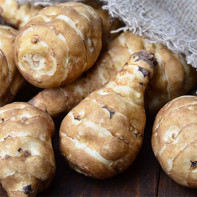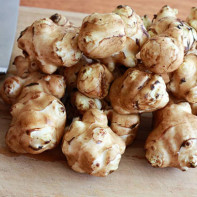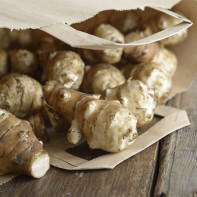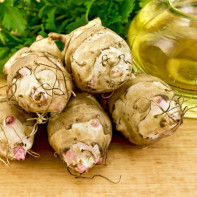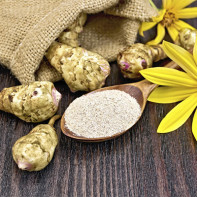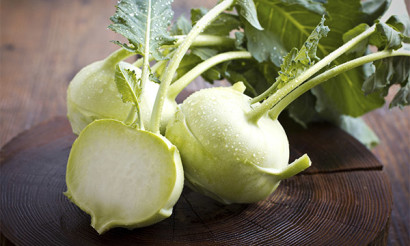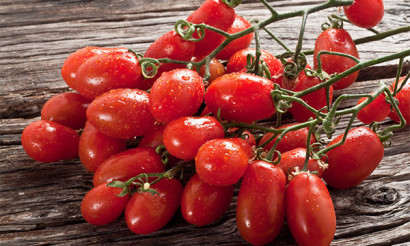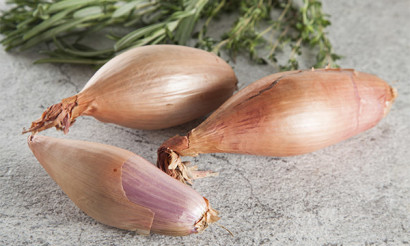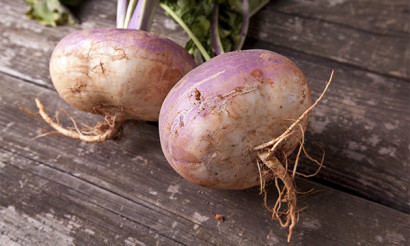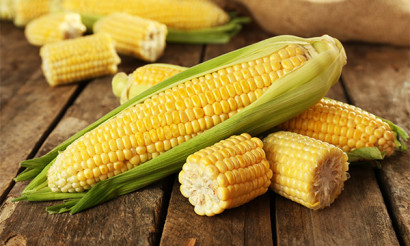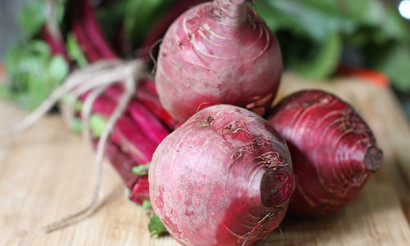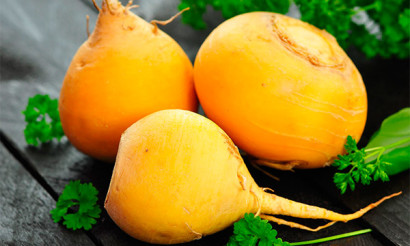Topinambur: what it is, useful properties and contraindications
In Russia, topinambur is not very popular. And that's a pity, since this product is a real superfood. Its main value lies in the fact that in its composition the topinambour corresponds to the strictest scientifically grounded requirements for a healthy diet and at the same time it has a pleasant taste. It helps people who lead sedentary lifestyles (almost inevitable in today's environment) to maintain good physical shape. In addition, it protects against adverse environmental influences and even psychological overload.
- What topinambur looks like and where it grows
- Types
- Composition and calories
- Useful properties of topinambour
- General benefits
- For women
- For Men
- In Pregnancy
- For breastfeeding
- For children
- When losing weight
- Jerusalem artichoke syrup: benefits and uses
- How to make the syrup
- What are the Topinambour leaves and flowers useful
- Dried Jerusalem artichoke benefits
- How to Dry
- Topinambour juice: benefits and harms
- Topinambour in medicine
- For diabetes
- In pancreatitis
- For gastritis
- In constipation
- In gout
- Topinambour-based folk medicine recipes
- Topinambour in cosmetology
- Harm and contraindications
- How to choose and store topinambour
- When to gather
- Can it be frozen?
- How to consume topinambour properly
- How much you can eat a day
- Is it possible to eat sprouted
- What you can make from topinambour: recipes
- Salad
- Puree
- Soup
- Coffee
- Jam
- Candied fruit
- Can we give topinambour to animals?
- Interesting facts about Jerusalem artichoke
What topinambour looks like and where it grows
Although the topinambour is a tuberous plant, it belongs to the genus Sunflower and the family Asteraceae. It is a herbaceous plant, which most often grows up to 1.5 m in height, but there have been known cases when there were four-meter specimens. If we return to its botanical description, we should note that its stem is straight and stout, pubescent with short hairs, its leaves are ovate, and it blooms with inflorescent baskets, which reach a diameter of 2-10 cm. They consist of tubular yellow flowers. In the conditions of the European part of Russia flowering takes place in August-October. The fruits of topinambur are seeds.
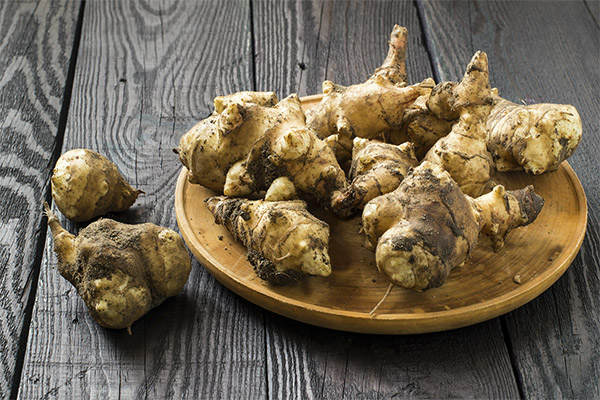
But in terms of nutrition and pharmacology it is grown for the sake of tubers, which are formed on the underground shoots of the ground pear (hence, incidentally, its name). A lot of tubers are formed, they have a cylindrical, rounded, often pear-shaped form. Their flesh is tender and juicy, and their taste is sweet. It was because of the edible tubers that the plant began to be cultivated in America, and then it came to the Old World.
In North America, topinambur can still be found today in its wild form.
Types
Currently, there are two main groups of varieties - early and late. The first includes such popular varieties as, for example, topinambur Red, Kiev white, Nakhodka, Skorospilka (here the name speaks for itself). Late varieties include Interest and Novosti. And many gardeners choose the Interes variety because it is three times better than potatoes in terms of yield, and these are very nutritious root crops.
Also, hybrids called topiary sunflowers have recently appeared on the market. They were actually bred by crossing topinambour with sunflowers. They differ from these crops in appearance and the very structure of the bush, because they are more stunted and their stems are thinner. Such hybrids include, for example, the Vostorg sunflower. Their advantage is that they retain all the useful dietary and medicinal properties of topinambour, but still get the ability of sunflower to remove salt deposits from the joints, which is very important for the treatment of the musculoskeletal system.
Composition and calories
The energy value of the ground pear is not high, it is about 72 kcal per 100 g.
You can often read that the tubers of this plant are close to potatoes in their chemical composition. To a certain extent, this is indeed true. They contain up to 3% protein, fiber and pectin, essential amino acids, a number of vitamins and minerals. At the same time, the ground pear completely lacks the alkaloid solonin, which is formed in the light in raw potatoes and has toxic properties. Also the topinambour does not contain saturated fatty acids.
Topinambour tubers contain such substances:
- Inulin is part of the unique carbohydrate complex of the ground pear, which also includes fructose. Inulin is the main component of the system, in the human body it is broken down to fructose, that is why topinambour is indicated for diabetes.
- Amino acids (there are sixteen in total, half of them are essential). Their structure is identical to the proteins of the thymus gland, which play an important role in the functioning of the immune system.
- Organic acids (malic, raspberry, succinic, citric). They have strong antioxidant properties.
- Dietary fiber. They contribute to the timely cleansing of the intestines from toxins.
- Silicon is a very important element, which is necessary for the normalization of metabolic processes. Just 50 grams of topinambour tubers will provide the daily requirement of this element.
- Iron is necessary for the processes of hematopoiesis, and its deficiency can lead to anemia.
- Potassium, calcium, sodium, zinc, phosphorus, nitrogenous substances.
- Carotenoids, B vitamins.
- Ascorbic acid, which is essential for strengthening blood vessels and acts as an antioxidant with anti-inflammatory properties.
- Fructose.
It should also be noted that ascorbic acid and silicon together significantly increase natural immunity. However, silicon is also essential for strengthening teeth and bones, and in these tubers it is combined with calcium, which has similar properties, so that the therapeutic effect is enhanced. Finally, it is silicon that gives topinambour its choleretic properties and prevents the formation of osteophytes in the joints.
Useful properties of topinambour
General benefits
The ground pear has many beneficial properties. Its benefits are as follows:
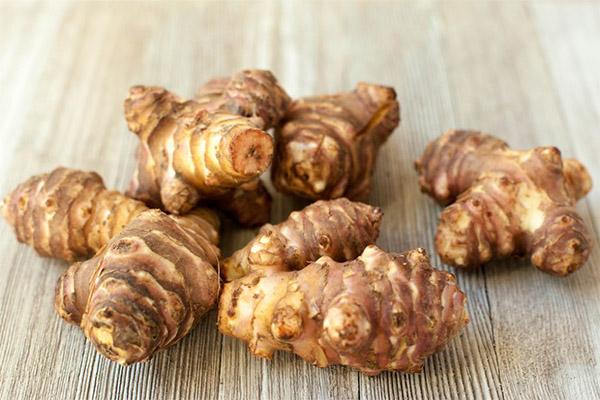
- Consumption of topinambour tubers helps to normalize digestion. This root vegetable allows you to create optimal conditions for the development of beneficial intestinal microflora, as well as gets rid of diarrhea and constipation.
- Topinambour has biliary properties, so it is recommended to use it for the prevention of stagnation.
- Since the ground pear contains a lot of fiber, it helps to eliminate toxins from the body faster. Therefore, its tubers are advised to eat those who live in areas with unfavorable environmental conditions.
- Due to the presence of inulin in the topinambour pulp, these root crops are recommended to be regularly consumed in diabetics to normalize blood glucose levels.
- The immunomodulatory properties of the ground pear are due to the fact that it contains silicon and vitamin C (although it is more contained in the green part of the plant, the tubers also have enough of it). The consumption of this vegetable during the fall and winter helps to prepare the body well for the season of colds.
The relatively recent studies have shown that the topinambour plays an important role in the prevention of cancer. It is also useful in treating diseases of the cardiovascular system. This is due to the fact that it contains potassium, which has a beneficial effect on the heart muscle and raises the level of hemoglobin in the blood. And, unlike ready-made pharmaceuticals, this root vegetable does not give any side effects.
Specialists believe that topinambour is also useful for those who are actively engaged in sports or work where they constantly experience high physical loads. The fact is that the tubers also contain arginine (one of the amino acids mentioned above) and phosphorus, and it is these that significantly increase the endurance of the body.
For women
A number of studies have shown that these root crops can prevent cancer, including the development of malignancies of the breast and uterus. This is due to the content of antioxidants. And the anti-inflammatory properties of these substances can prevent the development of diseases of the genitourinary system.
High iron content is not just the prevention of anemia. It helps to prevent muscle atony, myocardiopathy, and it is also a chance to get rid of increased fatigue. Also the unique chemical composition of the earth pear makes its tubers very useful for maintaining the beauty and health of hair, teeth and nails.
For men
The benefits of earth pear tubers for the stronger half of mankind is that they contain zinc, ascorbic acid and other antioxidants that have anti-inflammatory properties and help prevent prostate inflammation. In addition, zinc is useful in that it is generally beneficial to the reproductive system.
The potassium contained in the tubers not only regulates the water and acid balance, but also helps to normalize blood pressure and improve heart function. Topinambour is recommended to eat in case of hypertension, atherosclerosis, CHD, tachycardia (as we know, men are more prone to this disease). At the same time, to get the daily norm of potassium, it is enough to eat only 300 grams of tubers of ground pear - and this is about a portion of soup or salad, the recipes of which will be given below.
Finally, it is worth noting that this vegetable contains a large amount of thiamine, which is a vitamin that is essential for normal carbohydrate metabolism. It is very necessary for those who regularly engage in sports. In addition, topinambour is useful not only for physical activity, but also for mental activity.
In pregnancy.
Topinambour is very useful for future mothers, because it provides the body with all the necessary substances and at the same time allows maintaining a normal weight due to its small caloric content. Besides, it prevents anemia, and during the second half of pregnancy it becomes an excellent cure for constipation, which many women face during this period. Expectant mothers are even advised to eat one raw tuber of topinambour per day, peeling it like an apple. But you can not get carried away, so as not to have flatulence.
When breastfeeding
During lactation, raw topinambour should be eaten in moderation, so that it does not cause increased gas and colic in the child. Otherwise, there are no serious restrictions. On the contrary, the ground pear will help the young mother to quickly get into shape after childbirth, will remove swelling, will get rid of excess weight and at the same time will provide the body with all the necessary vitamins.
For children
Topinambour has no contraindications or side effects that would not allow giving it to children over three years old. But toddlers should not be offered raw ground pear, as it can cause severe gas and colic. You can only add the tubers of the plant to the soup instead of potatoes (if the child is of an age when it is allowed to eat such vegetables).
Otherwise, topinambour is very useful for children. It helps to strengthen the immune system, to prevent anemia and colds.
For weight loss
Topinambour is an ideal substitute for potatoes for those who want to lose weight (primarily due to its low calorie content). However, it has also been proven to speed up the metabolism, which promotes weight loss. In addition, it contains a lot of pectins, which, on the one hand, contribute to an effective and gentle colon cleansing, and on the other hand, become a source of food for beneficial bacteria. These microorganisms contribute to a better breakdown and digestion of food, which also allows you to lose weight.
Finally, the above-mentioned inulin helps to normalize lipid metabolism and stop the accumulation of "bad" cholesterol. In addition to the fact that it is the prevention of atherosclerosis, it also provides getting rid of excess weight.
Jerusalem artichoke syrup: benefits and applications
Topinambour syrup is used as a sweetener, which is very useful for those who suffer from obesity or diabetes. Very often it is sold in stores already prepared. This is a manufactured syrup, which should not include anything other than the earth pear itself and citric acid as a safe preservative. Syrup is obtained from the tubers of topinambur by boiling them at low temperatures. This product has a sweetish honey flavor, but it is not sugary, which distinguishes it from a similar sweetener made from agave.

Thus, topinambour syrup regulates blood sugar levels, improves digestion and regulates the metabolism.
How to make syrup
The syrup can also be prepared at home. Contrary to popular misconception, it doesn't even require sugar. All you need is 1 kg of topinambour and freshly squeezed lemon juice, which will act as a preservative.
The tubers of ground pear are washed and peeled, then ground in a meat grinder or blender, after which this mass is squeezed through gauze and get the juice. This liquid is poured into an enamel saucepan and put on the fire. The syrup should be heated to 50-60 degrees, and then reduce the heat to minimum and leave the syrup to simmer. Natural biochemical processes occur in the juice to produce a more viscous sweet liquid. The procedure with heating and natural cooling is repeated 5-6 times until the syrup is the desired thickness. Before the last heating, lemon juice is added to the syrup.
Then the syrup is poured into any pre-prepared sterile containers and tightly corked lids. The product can only be stored in the refrigerator.
What are the leaves and flowers of the topinambour useful
Both the leaves and flowers of the topinambour contain many useful substances. Both are used to make tea, but they are used separately, as they differ significantly in their properties. For example, the leaves of the ground pear, collected before flowering, contain pectin, mineral salts and iron. Tea or infusion of topinambour leaves is used to treat gout, remove toxins from the body, normalize blood sugar levels.
At the same time, topinambour flowers have choleretic properties. Tea from such raw materials normalizes the level of hemoglobin in the blood and helps to reduce the manifestations of gastritis at exacerbation.
The benefits of dried topinambour
Ground pear in dried form retains almost the same substances as in the raw form. And it is proved that in this case their content increases significantly due to the fact that moisture escapes from the product. By the way, in the pharmacy dried topinambour is often sold in the form of powder. And this is a very good solution, because it is almost impossible to preserve it otherwise for a long time. And the powder is not only useful, but also in a certain sense a convenient product, because it can be added to any dishes and drinks. In general, it has the same properties as raw root vegetables - it normalizes blood sugar levels, speeds up metabolic processes, increases immunity, etc.
How to Dry
Dry, of course, tubers of ground pear, having previously selected healthy fruits. They are carefully washed, peeled of the skin and cut into thin plates.
There are several ways to dry them at home:
- In an electric dryer. This is the fastest method of drying. The plates of topinambour, prepared in the described way, are placed on grids. The temperature in this unit is set at 50-60 degrees. In this mode, the earth pear is dried for four hours, sections are recommended to change places periodically.
- In an oven. This is a more convenient and versatile way, since the dryer is not in every house. In this case, you need to prepare the topinambur, washing and peeling it from the skin. Its thinly sliced slices are placed on a baking tray, covered with parchment. The topinambour is spread out so that the slices do not touch each other. Drying is done at a temperature of 50 degrees. On average, this procedure takes up to three hours. But after that, the topinambour is left on the table for another day. Then it is sent to dry again, only this time the slices are turned. If desired, if the topinambour will be used only for culinary purposes, you can sprinkle salt or add aromatic herbs to taste.
- Drying in the sun. This is the most affordable way, but also the longest. Root vegetables are prepared in the same way, and then they are spread out to dry in the air. This procedure generally takes about 4-5 days.
Dried topinambour should be stored in a paper or cloth bag, but the usual glass jar with a screw cap will do. The main thing is that she stood in a dark place, and it was not exposed to sunlight.
Topinambur juice: benefits and harms
Many people confuse topinambour juice and its syrup. But in fact they are two completely different products, although they have common properties. Juice is called the freshly squeezed liquid obtained from the root crops. It does not go through any additional processing. While the syrup is brought to a boil, subjected to heat treatment, which destroys some of the useful substances.
The easiest way to get juice is to make it in a juicer, having previously washed the ground pear and peeled it from the skin. Even with the juicer the pulp remains, so you need to squeeze it again through gauze - you will get juice, which can be added to the previously squeezed. You can manage without a juicer, using a blender or meat grinder and squeezing the rest through gauze. How to drink the juice for medicinal purposes will be discussed below.
Topinambur in medicine
Due to its useful properties, topinambur is widely used both in folk and in official medicine. With its help, not only diabetes mellitus is treated, but also diseases of the musculoskeletal system, including osteochondrosis and osteoarthritis.
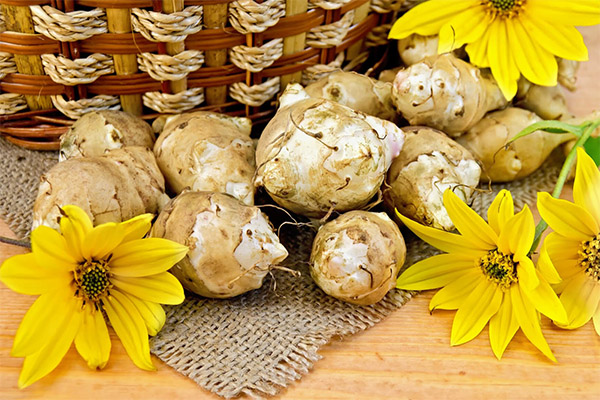
In case of diabetes mellitus.
As noted above, inulin promotes the utilization of glucose in the human body. That is why it is useful for diabetes. Recent studies have also proven that it can improve liver and pancreatic function in complications caused by diabetes. Therefore, with this disease, it is useful both to include the ground pear in the daily menu and to drink freshly squeezed juice from its tubers.
Important: The glycemic index of topinambour is 30 units.
In pancreatitis.
This term defines an inflammatory disease of the pancreas. In its acute form, a therapeutic fasting is generally shown, and topinambour should not be included in the diet. But in prolonged remission it can and should be eaten, because it contains inulin, which improves the work of the pancreas. Only more often earth pear in gout is consumed, as well as other vegetables, in a boiled form, because in raw form there is a great risk that the tubers provoke increased gas formation.
Gastritis
In this disease, raw topinambour should not be eaten either. But its syrup and decoctions are used to improve the condition of the mucous membrane of the stomach and to treat this disease in general.
With constipation
Thanks to the content of dietary fiber, the tubers act as a mild laxative. For this, it is not even necessary to use any complicated recipe, just include the raw ground pear in your diet.
For gout.
This disease is associated with deposits of uric acid salts. Topinambour, unlike many other vegetables, not only does not contain purines, which could increase the level of uric acid, but also allows the removal of accumulated salts. In addition to the fact that in gout, topinambour can be consumed in raw and boiled form, there are several other recipes of folk medicine:
- Topinambour and cherry juice. They are mixed in equal proportions. The resulting drink is drunk in small sips, 1 glass three times a day before meals.
- A mixture of grape juice, topinambour and apple, taken in equal proportions. Such a combination perfectly neutralizes uric acid. Drink it in the same way as the drink described above.
- Infusion of the leaves and stems of topinambour. For this, take the stems from the top of the plant, as well as the leaves, chop them, select 2 tbsp. of this mixture and pour two glasses of boiling water. The remedy is left to infuse for the night. In the morning it is filtered through gauze. Drink it to 50 ml four times a day, the course duration - 10 days.
Some phytotherapists recommend taking an infusion of topinambur flowers in gout, which is prepared in the same way as the above remedy from the stems. But since even dried flowers contain useful substances in a higher concentration, only 1 tbsp. of raw materials is taken for 2 cups of boiling water.
Topinambour-based folk medicine recipes
Topinambour helps with a wide variety of diseases. In folk medicine, recipes for its use appeared long before the benefits of the ground pear were proven by science. For example, you can use the following remedies:
- Tincture for atherosclerosis. In equal proportions take the leaves of ground pear, marjoram and melissa, from this volume select literally 1 tsp. which is poured with a glass of boiling water and infused for 30 minutes. Before using it, it is filtered. Such a drink can be drunk up to two glasses a day. In the absence of contraindications, honey is also added there.
- Tincture for gastritis. In equal proportions, dry inflorescences of ground pear, apothecary chamomile, melissa leaves and topinambur are mixed. Of this volume, only 1 tsp. is taken per glass of boiling water. Infuse it for 15 minutes and drink 2 glasses a day.
- A bath for the treatment of diseases of the musculoskeletal system. A decoction of topinambour flowers and stems is prepared for it. Take 100 grams of stems and flowers of topinambour for 1 liter of cold water. Bring it to a boil, simmer over low heat for 30 minutes, then strain and pour into the bath water.
- Juice. For anemia, it is recommended to drink two glasses of topinambur juice a day - before breakfast and before going to bed.
From diabetes, it is recommended to take half a glass of juice and dilute in equal proportions with water. Gradually you will need to bring the remedy to one glass, if there is no individual intolerance.
Topinambur in cosmetology
The ground pear is very useful for the skin. Basically, various masks are prepared from the root vegetable and its juice. For example:
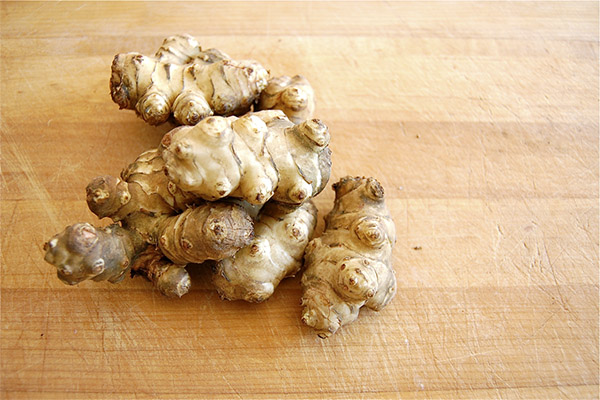
- Anti-aging remedy. One or more (depending on the size) topinambour tubers are grinded on a grater and, without draining the juice from the resulting mass, add a spoonful of honey to it. This composition is applied to cleansed skin for 20 minutes, then rinse with warm water. It is recommended to do such a mask every other day, best of all, as a course of three weeks, between which a break is mandatory.
- Mask for dry skin. Take a club of Jerusalem artichoke, get rid of the skin, grind it on a grater, wait to let out the juice, then mix all this mass with a spoonful of olive or almond oil, apply the mixture to the face and keep for half an hour, and then wash off with warm water. In this case, a course of three weeks will give good results.
- Remedy for oily skin. Topinambour can normalize the production of sebum. To do this, grate the tuber and add to it literally 2 tablespoons of fat-free milk. The mixture is applied to the skin for half an hour, then rinse. The course duration - two weeks, and to do such a mask can be done every other day.
- Lotion from black spots. A few topinambour tubers are used to make a juice, which is wiped over the face twice a day, in the morning and in the evening.
For hair more often topinambour juice is used, which contains a lot of iron, copper and vitamin C. All these components allow to improve the condition of the hair and increase the production of collagen. Also the juice allows to fight with seborrhea, not so much due to its antibacterial effect, but due to the normalization of the sebaceous glands. Topinambur juice is added to water to rinse hair. It can also be rubbed into the scalp. After application, it is left for a few minutes, and then washed off.
Harms and contraindications
Fortunately, topinambour contains no harmful substances. But at the same time, when consuming it in its raw form, it is necessary to observe moderation, because it contains many substances that contribute to increased gas formation. They can cause an unpleasant feeling of heaviness in the stomach. Thermal processing destroys these substances, but the amount of vitamins is reduced.
We should also not forget that, like any other plant product, ground pear can cause individual intolerance. In such cases, you can not consume the product, of course. But there are no other contraindications for topinambour.
How to choose and store topinambour
When choosing a topinambour, you need to pay attention to its texture. The root-crop should be hard enough, dense and elastic, while shriveled, soft and flaccid tubers can be thrown away immediately, they are not worth cooking, and they will not be stored for a long time. The skin of an earth pear should not show any defects, damages and spots, although roughness is allowed.
Earth pear is recommended to store in a plastic bag, or better in a paper bag in the refrigerator. But in this case, the storage period will be no longer than two weeks. In urban apartments, a large amount of topinambur can be stored only on an unheated balcony, in a wooden box. In such conditions, it can be stored from one to three months. The latter, however, is quite rare.
When to harvest
Harvest the topinambour at the end of October - beginning of November. For this purpose, the stems are cut in advance and the plant is carefully dug up so as not to damage its tubers. The later the harvest, the larger the size of the root-crops and the higher the content of vitamins and minerals.
Can I freeze?
Those who grow earth pear themselves know that it tolerates frost well. Therefore, in theory, it can also be frozen. But it should be taken into account that at subzero temperatures the biochemical processes in the course of which inulin is converted into fructose begin. That is, frozen tubers will have a sweeter taste than fresh ones. But freezing allows you to overcome the main disadvantage of topinambour - its short shelf life. Because of low temperatures it will not be threatened by pathogenic bacteria and will retain its structure and color. It is clear that after defrosting, the topinambour cannot be eaten raw, but it can be cooked or soup can be prepared with it.
To freeze the ground pear can be done in different ways, including grating, slicing, simply removing the skin, placing it in the freezer as a whole. Many cooks advise blanching topinambour in water or steam, i.e. to immerse it for a few seconds in a boiling environment. In this way, it is possible to preserve the original flavor of the product.
The biggest disadvantage of freezing - it is suitable only for those cases where the volume of the crop is small, and it can all fit in the freezer.
How to consume topinambour properly
In the olden days there was a saying that any product is both a poison and a cure, everything depends only on the dose. This is also true for topinambur.

How much you can eat a day
In raw form, you can eat up to 150 g of topinambour a day - this is the norm for an adult. And then experts recommend dividing it into three meals - for example, you can prepare a salad of fresh root crops for breakfast, lunch and dinner. If we are talking about boiled or baked ground pear, then the recommended amount is increased to 300 g - for example, in a puree or cream soup.
Syrup from topinambour can be used as a sweetener, it is often added to tea or coffee by people suffering from obesity or diabetes. No more than 3 tablespoons can be eaten per day.
Finally, the tea is brewed not from the roots, but from the leaves of the topinambour - for 500 ml of boiling water goes only 1 tbsp. of vegetable raw materials. The finished drink should be just enough for three meals.
Is it possible to eat sprouted
If sprouted potatoes contain solanine, the topinambour does not have this substance. But it is still better not to eat vegetables that have reached such a state - there is nothing useful in them anymore.
What can be cooked from the topinambour: recipes
In European cuisine, topinambur is the most widespread. It is steamed, baked, boiled, mashed and souffléed, stewed with cream sauce and served as a garnish to meat dishes. In order that it does not lose its light hue, it is recommended to add a small amount of lemon juice to the water for its cooking. Also, in order to preserve as many vitamins as possible, it is recommended to cook the ground pear in its peel. In general, it is quite difficult to remove because of its small thickness. Very often a lot of valuable pulp is thrown out together with it. To avoid this, experienced cooks recommend blanching the root vegetable.
Salad
A very tasty and healthy salad can be made from topinambour and cherry tomatoes. For this, for 0.5 kg of topinambour take 150 grams of cherry tomatoes, and for the dressing - half a glass of freshly squeezed orange juice, 3 tablespoons of vegetable oil, a pinch of mixture "Provence herbs", ground black pepper and sea salt to taste.
Topinambur is peeled from the skin and cut into medium sized slices. The cherry tomatoes do not need to be cut, but if they are too big, they can be cut in half. Then mix salt, pepper, provincial herbs, sprinkle them on topinambur and cherry tomatoes and bake in an oven heated to 150 degrees. Cooking time is about 20 minutes. 5 minutes before the end of the process, the vegetables are poured with a dressing of vegetable oil mixed with orange juice.
Mashed potatoes
This dish is quite capable of replacing the mashed potatoes. For its preparation take 0.5 kg of topinambour, 2 tablespoons of low-fat cream, salt and spices to taste, up to 1 tsp. spoonfuls of olive oil. The topinambour is peeled, trying to cut off as little pulp as possible. Then they are put in water and boiled for about 20 minutes until they become soft. After that, remove the root vegetables from the water and beat in a blender to a purée, adding salt and cream, butter, and if desired, other spices. You can also mash the tubers with an ordinary pusher, but this will take more time.
Soup
Topinambour is most often used to make a cream soup. It can be served with baked pumpkin or grilled mushroom kebabs. The easiest way to serve it is with croutons. And it is cooked very simply. For 0.5-0.6 kg of topinambour you need one large stalk of leeks with its delicate flavor and spicy smell, 200 g of cottage cheese, not too much fat cream, a couple of cloves of garlic, salt, black pepper, spices and smoked paprika to taste.
Peel the topinambur and pour water, add salt and boil until soft. Chop leeks and garlic finely and pass them in vegetable oil. Then, all this is added to the soft topinambour, put cottage cheese, pour the cream and whip in a blender. Return the soup on the stove, bring it to the boil, pour it onto plates and sprinkle with aromatic herbs and chopped smoked paprika.
Coffee
It is not quite correct to call it coffee, but it can really replace an espresso. Coffee is prepared in this case from the powder, for the preparation of which 10 tubers of topinambour are needed. The ground pear is thoroughly washed, peeled and grated on a fine grater. Then this mass is fried in a dry thick-walled pan, stirring constantly. The fire should be minimal. This process will take about 10 minutes. Roasted in this way, topinambour is ground in a coffee grinder to a powder. To prepare one portion of the drink you will need 2 tsp. powder per 100 ml of water. It is prepared in the same way as real coffee, in a jazz bowl. You can add 1 tsp. sugar or sugar substitute. Bring the coffee to a boil, leave it on low heat for 1-2 minutes, then let it brew for another 5 minutes.
Jam
In stores today, topinambour jam, produced in a factory, is sold. But you can also cook it at home, the more so that the "cold" method is most often used for this purpose. Such jam does not need to be boiled, and at the same time it allows preserving more useful substances. The final product has a very peculiar, but pleasant taste. It can be used as an independent dessert, added to porridge or pancakes, used as a filling for pies.
For jam for 1 kg of ground pear take 250 g of flower honey and 2 lemons. Topinambour tubers are peeled from the skin and ground on a grater, then add honey to the resulting puree and leave to infuse for 15 minutes. Meanwhile, the lemons are washed, cut into several pieces, remove the pips, and then the pulp along with the skin is ground in a blender. Both pureed masses are combined and mixed, and then transferred to sterile jars. This jam can be stored for several months, up to a maximum of six months.
In the above recipe, you can take an orange instead of one lemon - the taste will be richer.
Cucates
Succulents from topinambour are an excellent alternative to harmful confectionery products.
It is easy to cook them. Take 80 grams of powdered sugar and 150 grams of honey per 100 grams of ground pear. Tubers are cleaned, cut into thin plates. Honey is diluted in half a glass of clean water, and in the resulting mixture soaked the prepared plates of topinambur for half an hour. Then, these slices are spread out on a baking tray and heated in an oven at minimum temperature. The readiness will have to be determined experimentally. It is important that the slices do not become too dry. When they're ready, they're dipped in powdered sugar.
Can we give topinambour to animals?
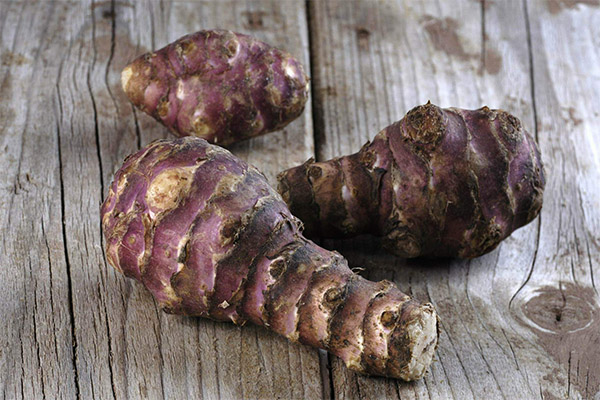
Topinambour tubers are eagerly eaten by rabbits, sheep and goats. They can even be given to cattle. This is really a very useful product, which provides animals with vitamins and improves digestion. But, unfortunately, the tubers cannot be stored for a long time. However, the topinambour is used to make flour, which is added to the food, and even for the pets - dogs and cats. So the topinambour in this or that form is useful for all animals.
Interesting facts about topinambour
Topinambour is a plant that is known under many different names. It first came to Europe in the 17th century with the Indians of the Tupinambu tribe. The root crops were named accordingly in France and Portugal. But in some countries they are called earthen pear, which is explained by the shape of the tubers, barabole - by analogy with potatoes and even Jerusalem artichoke. The latter is due to the fact that in Italy, apparently, they knew that the topinambour is a relative of the sunflower and called it by the same name as this flower - girasole. And this word was later distorted to Jerusalem.
Anyway, it is a very useful plant. It is resistant to frost, drought and even acid rain. Some experts assure that the topinambour does not even accumulate pesticides and other agricultural chemicals in significant concentrations, which cannot be said about other plants. Finally, it promotes soil cultivation, which is very important for efficient farming. Also, the ground pear is very intensive in producing oxygen and absorbing carbon dioxide.
«Important: All information on this site is provided for informational purposes only for informational purposes only. Before applying any recommendations, consult a health care professional. specialist. Neither the editors nor the authors shall be liable for any possible harm caused by materials."

